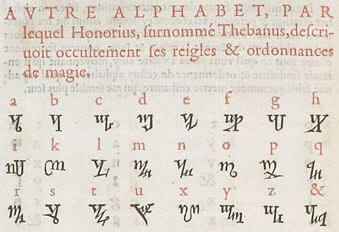Type Alphabet Time period 16C–present | Creator uncertain | |
 | ||
Parent systems Latin alphabet (cipher)Theban | ||
The Theban alphabet is a writing system with unknown origins which first came into publication in the 16th century.
Contents
Publication history
It was first published in Johannes Trithemius's Polygraphia (1518), in which it was attributed to Honorius of Thebes "as Pietro d'Abano testifies in his greater fourth book". However, it is not known to be extant in any of the known writings attributed to D'Abano (1250-1316). Trithemius' student Heinrich Cornelius Agrippa (1486–1535) included it in his De Occulta Philosophia (Book III, chap. 29, 1531). It is also not known to be found in any manuscripts of the writings of Honorius of Thebes (i.e. Liber Iuratus Honorii, or The Sworn Book of Honorius), with the exception of the composite manuscript found in London, British Library Manuscript Sloane 3853, which however openly identifies Agrippa as its source.
Uses and correlations
It is also known as the Honorian alphabet or the Runes of Honorius after the legendary magus (Theban is not, however, a runic alphabet), or the witches' alphabet due to its use in modern Wicca and other forms of witchcraft as one of many substitution ciphers to hide magical writings such as the contents of a Book of Shadows from prying eyes. The Theban alphabet bears little resemblance to other alphabets, and has not been found in any previous publications prior to Trithemius'.
There is one-to-one correspondence between Theban and the letters in the old Latin alphabet. The modern characters J, U and W are not represented, and in modern usage these are transliterated using the Theban characters for I, V and VV. Theban letters only exist in a single case. This suggests an origin for Theban as a cipher calqued on Latin, along with the various alphabets described by Trithemius and Agrippa, based on either Latin or Hebrew.
Eric S. Raymond, an American software developer and author, has created a draft proposal for adding the Theban alphabet to the Universal Coded Character Set / Unicode.
